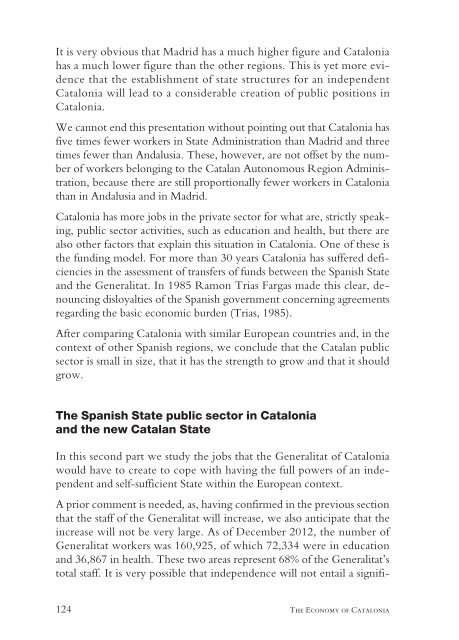The Economy of Catalonia
the_economy_of_catalonia._questions_and_answers_on_the_economic_impact_of_independence
the_economy_of_catalonia._questions_and_answers_on_the_economic_impact_of_independence
Create successful ePaper yourself
Turn your PDF publications into a flip-book with our unique Google optimized e-Paper software.
It is very obvious that Madrid has a much higher figure and <strong>Catalonia</strong><br />
has a much lower figure than the other regions. This is yet more evidence<br />
that the establishment <strong>of</strong> state structures for an independent<br />
<strong>Catalonia</strong> will lead to a considerable creation <strong>of</strong> public positions in<br />
<strong>Catalonia</strong>.<br />
We cannot end this presentation without pointing out that <strong>Catalonia</strong> has<br />
five times fewer workers in State Administration than Madrid and three<br />
times fewer than Andalusia. <strong>The</strong>se, however, are not <strong>of</strong>fset by the number<br />
<strong>of</strong> workers belonging to the Catalan Autonomous Region Administration,<br />
because there are still proportionally fewer workers in <strong>Catalonia</strong><br />
than in Andalusia and in Madrid.<br />
<strong>Catalonia</strong> has more jobs in the private sector for what are, strictly speaking,<br />
public sector activities, such as education and health, but there are<br />
also other factors that explain this situation in <strong>Catalonia</strong>. One <strong>of</strong> these is<br />
the funding model. For more than 30 years <strong>Catalonia</strong> has suffered deficiencies<br />
in the assessment <strong>of</strong> transfers <strong>of</strong> funds between the Spanish State<br />
and the Generalitat. In 1985 Ramon Trias Fargas made this clear, denouncing<br />
disloyalties <strong>of</strong> the Spanish government concerning agreements<br />
regarding the basic economic burden (Trias, 1985).<br />
After comparing <strong>Catalonia</strong> with similar European countries and, in the<br />
context <strong>of</strong> other Spanish regions, we conclude that the Catalan public<br />
sector is small in size, that it has the strength to grow and that it should<br />
grow.<br />
<strong>The</strong> Spanish State public sector in <strong>Catalonia</strong><br />
and the new Catalan State<br />
In this second part we study the jobs that the Generalitat <strong>of</strong> <strong>Catalonia</strong><br />
would have to create to cope with having the full powers <strong>of</strong> an independent<br />
and self-sufficient State within the European context.<br />
A prior comment is needed, as, having confirmed in the previous section<br />
that the staff <strong>of</strong> the Generalitat will increase, we also anticipate that the<br />
increase will not be very large. As <strong>of</strong> December 2012, the number <strong>of</strong><br />
Generalitat workers was 160,925, <strong>of</strong> which 72,334 were in education<br />
and 36,867 in health. <strong>The</strong>se two areas represent 68% <strong>of</strong> the Generalitat’s<br />
total staff. It is very possible that independence will not entail a signifi-<br />
124 <strong>The</strong> <strong>Economy</strong> <strong>of</strong> <strong>Catalonia</strong>


